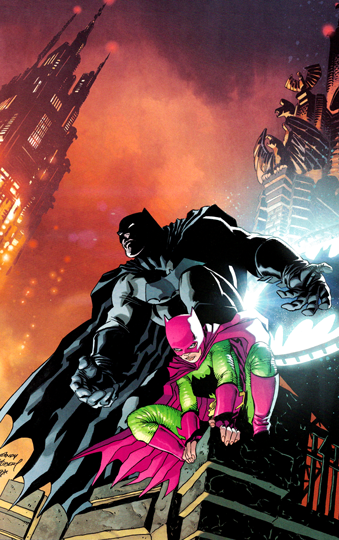 This post is a review of Frank Miller’s Dark Knight Universe and the third installment in the critically acclaimed series, DK III: The Master Race. DK III is co-written by Frank Miller and Brian Azzarello, currently out with five books out of a series of eight. Since it’s inception in 1986, the Dark Knight Returns was the graphic novel that began the Dark Age of comic books, a permanent genre-wide change still felt today in comics and graphic novels and now films. Arguably, Miller’s avant garde work raised comic books as an artform into the same category as “serious” literature, making way for the Hugo award-winning Watchmen in 1988 and Pulitzer Prize winning Maus in 1992.
This post is a review of Frank Miller’s Dark Knight Universe and the third installment in the critically acclaimed series, DK III: The Master Race. DK III is co-written by Frank Miller and Brian Azzarello, currently out with five books out of a series of eight. Since it’s inception in 1986, the Dark Knight Returns was the graphic novel that began the Dark Age of comic books, a permanent genre-wide change still felt today in comics and graphic novels and now films. Arguably, Miller’s avant garde work raised comic books as an artform into the same category as “serious” literature, making way for the Hugo award-winning Watchmen in 1988 and Pulitzer Prize winning Maus in 1992.
Miller’s muscular interpretation of the Batman in the Dark Knight Universe is modern mythology, an iconoclasm of the barely-serious camp seen in the 1960’s Batman live action TV series and Super Friends cartoons of the 1970-80’s. Gotham City is a gritty, visceral film noir skyline full of gargoyles and deco gothic architecture that oozes tension from every shadow. The familiar characters surrounding Batman are also portrayed with deeper dimension, their flaws making them more engaging. Wonder Woman and Superman are lovers, their child is a moody teenage Supergirl named Lara, and the Joker is a homicidal sociopath instead of a wisecracking robber. Bruce Wayne struggles with his aging physique more so than the previous two Dark Knight series, now unable to engage foes with the same level of “blunt trauma” as before. This touch of realism makes DK III more interesting not only because it makes Batman’s challenges more difficult but also by giving longtime fans (myself included) a hero they can identify with.
Miller’s Dark Knight Universe draws realtime parallels to modern day events and zeitgeist of an ever changing America. Runaway capitalism, urban racial tensions, even the ubiquity of social media and cell phones are woven into the storyline. Fear, Batman’s greatest ally, is the unifying refrain in all three DK titles. In the 1980’s Reagan decade it was the fear of nuclear war (The Dark Knight Returns or DK I). In the 2000’s, the banal psy-op fascism of the Bush decade is seen in the villainy of Lex Luthor and Brainiac (The Dark Knight Strikes Again DK II). Today, the abomination of fearful police murdering unarmed African American citizens is clearly recognizable in Dark Knight: The Master Race, (DK III). The army of Supermen led by the fanatical Quar represent the misguided trigger fingers of the racist police officers who, like the Kryptonians, wield the state-granted power of life and death. Even after suppressing Batman’s allies including The Flash, Green Lantern and The Atom, the Kryptonians are outwitted by the Dark Knight and are forced to meet the citizens of Gotham in combat in the most recent issue of DK III.
While artists Andy Kubert and Klaus Janson are the penciler and inker on DK III, the artwork retains some of Miller’s distinct style. His artistic concerns are expressionism and composition rather than lifelike realism. The chiaroscuro silhouettes and characters’ faces make reading an emotional experience, allowing us to feel the action directly. Miller’s characters have a statuesque quality, evoking ancient greek mythology in the way they are more carved from marble then drawn with pencil and ink. Miller’s art is moving in a more instinctive, metaphoric direction where he freely distorts certain characters for emotional impact. One panel of the Batgirl minicomic (penciled and inked by Miller himself) even transforms an angry mob pursuing Batgirl into a piranha, calling to mind the poetry of Federico Garcia Lorca.
Of special interest is the development of Caroline Keene Kelley, a hero introduced in DK I. The Dark Knight universe was the first to use the gender switch device now so popular in Marvel comics today, as evidenced by Thor, Wolverine and now Iron Man Batman’s sidekick Robin, slain by the Joker long before the incidents of the original Dark Knight Returns, lives again in the character of Carrie Kelly, a brave teenage girl inspired by his reappearance during the first issue of DK I. Kelly proves herself worthy of the mask after saving Batman’s life during combat with the mutant leader, impressing him with courage and ingenuity beyond her years. She switched her hero identity to Catgirl in DK II, still remaining Batman’s partner but expressing another aspect of her identity through her Catgirl persona.
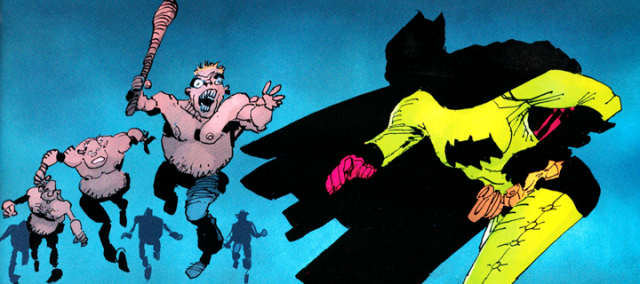
Kelly eventually earns the title of Batgirl in DK III, her 1980’s punk rock inspired green and purple costume demonstrating how taking artistic risks is one of Miller’s most entertaining assets. The Batgirl #1 mini comic included in DK III issue #4 is a remarkably enjoyable episode. Passages of it transcend the superhero genre in how the mob chasing Batgirl as she carries out her mission seems to be a group of inhuman orcs and ogres wielding primitive melee weapons. Her encounter with Aquaman riding a monster hammerhead shark again evokes Greek mythology in his resemblance to Poseidon, god of the sea. This kind of sci fi fantasy imagery juxtaposed with bleeding edge street dialogue make Miller’s DK III: The Master Race the future of the graphic novel landscape.












 mysticism. Recall the Sith Lord Darth Vader in A New Hope speaking about the Death Star, “The ability to destroy a planet is insignificant next to the power of the Force“.
mysticism. Recall the Sith Lord Darth Vader in A New Hope speaking about the Death Star, “The ability to destroy a planet is insignificant next to the power of the Force“.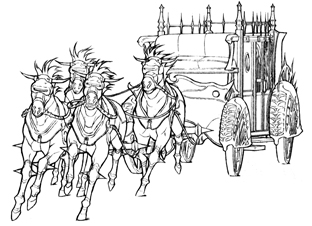 Some content has an even balance of both genres, such as the Saga graphic novel from Image First and Vampire Hunter D videos and manga. These examples weave a tight assimilation of both genres which makes them more engaging than if the stories were purely sci fi OR fantasy. The rising popularity of sci fi fantasy may be due to creators of strictly science fiction or fantasy finally running out of ideas for original material inside the stylistic boundaries of each genre. Maybe audiences really like the idea of adventure that weaves starships and spells, and content creators are simply producing what they want.
Some content has an even balance of both genres, such as the Saga graphic novel from Image First and Vampire Hunter D videos and manga. These examples weave a tight assimilation of both genres which makes them more engaging than if the stories were purely sci fi OR fantasy. The rising popularity of sci fi fantasy may be due to creators of strictly science fiction or fantasy finally running out of ideas for original material inside the stylistic boundaries of each genre. Maybe audiences really like the idea of adventure that weaves starships and spells, and content creators are simply producing what they want.
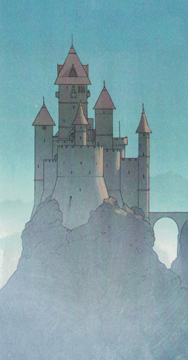 The story tells just how much comics and audiences have evolved in the 30 years separating the two versions of the Secret Wars. While the original Secret Wars was written so that new readers could get involved with the characters and action in any given issue, the 2015 version assumes its readers are familiar enough with the Marvel Universe to not need background information laid out for them. Also unlike its predecessor, the 2015 Secret Wars features a more obscure cast (Where’s Cap? Where’s Iron Man?), demonstrating how diverse and specialized Marvel titles have grown in the past 30 years. While the new version has some major plot holes, such as Dr. Doom being omnipotent but not omniscient (really, guys?), the story arc still pays off in the end.
The story tells just how much comics and audiences have evolved in the 30 years separating the two versions of the Secret Wars. While the original Secret Wars was written so that new readers could get involved with the characters and action in any given issue, the 2015 version assumes its readers are familiar enough with the Marvel Universe to not need background information laid out for them. Also unlike its predecessor, the 2015 Secret Wars features a more obscure cast (Where’s Cap? Where’s Iron Man?), demonstrating how diverse and specialized Marvel titles have grown in the past 30 years. While the new version has some major plot holes, such as Dr. Doom being omnipotent but not omniscient (really, guys?), the story arc still pays off in the end.
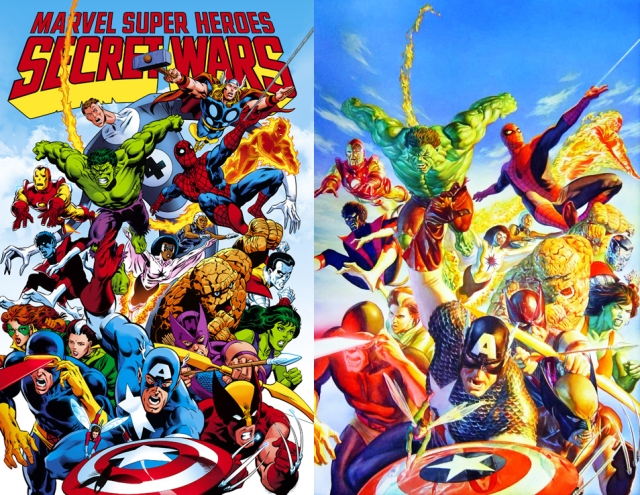 The only criticism is regarding the cover of the graphic novel which is based on the #1 issue in the series. Alex Ross, who painted the new cover following the original 1984 layout, is a master artist without peer, perhaps the very best in the industry. That said, the style of rendition he used works against the medium of comic books as a gateway for fantasy. To a degree, the less realistic the characters look the easier it is for readers to fantasize that they themselves are their favorite hero. Ross’s artwork looks like portrait paintings of real people, so detailed and lifelike that no one would ever recognize themselves in the heroes faces.
The only criticism is regarding the cover of the graphic novel which is based on the #1 issue in the series. Alex Ross, who painted the new cover following the original 1984 layout, is a master artist without peer, perhaps the very best in the industry. That said, the style of rendition he used works against the medium of comic books as a gateway for fantasy. To a degree, the less realistic the characters look the easier it is for readers to fantasize that they themselves are their favorite hero. Ross’s artwork looks like portrait paintings of real people, so detailed and lifelike that no one would ever recognize themselves in the heroes faces.

